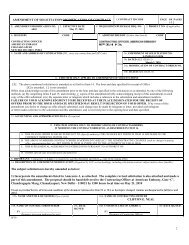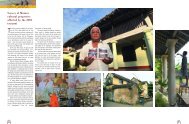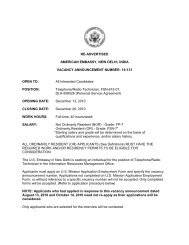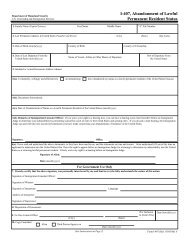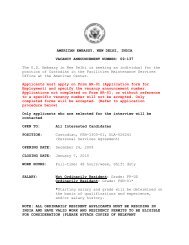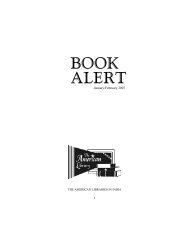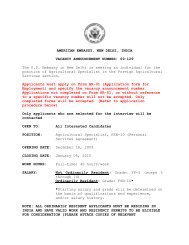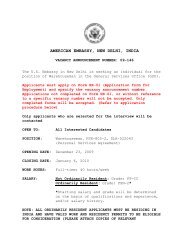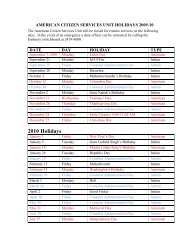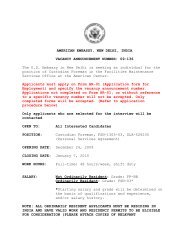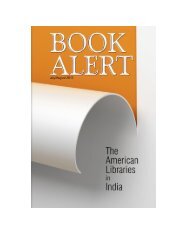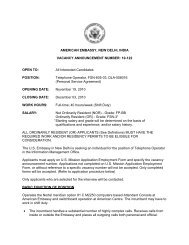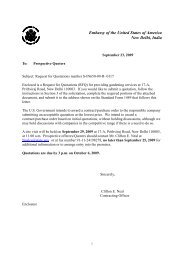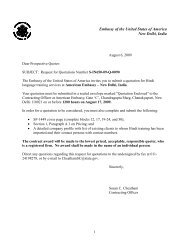Article & Web Alert (May/June 2009) - New Delhi
Article & Web Alert (May/June 2009) - New Delhi
Article & Web Alert (May/June 2009) - New Delhi
Create successful ePaper yourself
Turn your PDF publications into a flip-book with our unique Google optimized e-Paper software.
CONTENTSFocus Section: U.S. Foreign Policy: The ObamaAgenda 3Business & Economics 19International Political Relations & Security 20Democracy & Human Rights 21Communication & Information 22Global Issues 24U.S. Society, Values & Politics 25Science & Technology 28
<strong>Article</strong>s listed in <strong>Article</strong> & <strong>Web</strong> <strong>Alert</strong> areavailable at The American Library nearest to you.Should you wish to receive photocopy of any of thearticles, please fill in the attached reply-paid card withyour request and mail it to us. We shall mail you therequested articles. For your convenience, addresses ofthe four American Libraries in India are given on theinside front cover.As always, we welcome your comments andsuggestions. Please send your feedback to Mr. Steven P.Kerchoff, Information Resource Officer, Public AffairsSection, U.S. Embassy, The American Center, 24Kasturba Gandhi Marg, <strong>New</strong> <strong>Delhi</strong> 110001.Note: Internet sites included in this publication, other thanthose of the U.S. government, should not be construedas an endorsement of the views contained therein.Researched, compiled and edited by Sanjay Kumar Bhagat,Public Affairs Section, U.S. Embassy, <strong>New</strong> <strong>Delhi</strong>.Email: BhagatSK@state.gov
F O C U SU.S. Foreign Policy: The ObamaAgendaA new chapter in the history of the United States began inNovember 2008 when Americans elected Barack Hussein Obamaas the first African American president of the nation. The worldlooked upon Obama as an ambassador of change as he filled inthe details of his campaign theme: "Change We Can Believe In."At a time when America continues to face unprecedented foreignpolicy and national security challenges, Obama has chosen tostart with a full sprint, signing executive orders within hours oftaking the oath of office. "Know that America is a friend of eachnation and every man, woman and child who seeks a future ofpeace and dignity, and that we are ready to lead once more" thepresident said moments after taking office, sending ripples ofoptimistic signals to the entire world.As president, Obama faces myriad upheavals on the internationalmap including weakening economy, conflicts in Iran andAfghanistan, widespread terrorism, proliferation of nuclearweapons, increasing assertiveness of Russia, rising military power ofChina, global climate change, the spread of poverty, infectiousdiseases and ethnic and religious strife worldwide. Havingcompleted his first 100 days as America's president, BarackObama has given significant indications about the contemporaryshifts and priorities in his foreign policies. In an hour-longnationally televised press conference on April 29, 2009, he saidin his own analysis of his first 100 days, "I think we're off to a goodstart. But it's just a start. I'm proud of what we've achieved, but I'mnot content."During his tenure so far, Obama has committed himself and hisadministration to a foreign policy that ensures the safety of theAmerican people. His foreign policy pledges to end the war inIraq responsibly, finish the fight against the Taliban and al Qaedain Afghanistan, secure nuclear weapons and nuclear materialsfrom terrorists, and renew American diplomacy to support strongalliances and to seek a lasting peace in the Israeli-Palestinianconflict. As promised in his election campaign, Obama is well onhis way to change the direction of America's foreign policy.In the first 48 hours of his presidency, Obama issued executiveorders to close the detention center on the U.S. naval base atGuantánamo Bay, Cuba within a year, to address the treatmentand legal status of detainees, and to ban enhanced interrogation3 ARTICLE & WEB ALERT
F O C U Smethods. He appointed Special Envoys for Climate Change,Southwest Asia, the Middle East, Sudan, and a SpecialRepresentative for Afghanistan and Pakistan. But perhaps thegreatest foreign policy shift during Obama's early days in officehas been his approach towards Iraq, which dominated U.S.policy for about six years. On February 27, 2009, the presidentannounced a plan to responsibly end the war in Iraq. In a speechto U.S. Marines at Camp Lejeune, North Carolina, PresidentObama stated that by August 31, 2010, the U.S. combat missionin Iraq will end. An improved situation in Iraq will pave way for thenew administration to look for opportunities to expand directdiplomatic engagement with Iran.In the South and Central Asia region, Obama is setting a new U.S.course for Afghanistan and Pakistan. Stating that it is an internationalsecurity challenge of the highest order, President Obama, onMarch 27, 2009, announced a new strategy for these two nationsthat aims to disrupt, dismantle and defeat al Qaeda and theTaliban. "We have to ensure that neither Afghanistan nor Pakistancan serve as a safe haven for al Qaeda." In an interview on March29, 2009, Obama called the new plan "a comprehensive strategythat doesn't just rely on bullets or bombs, but also relies onagricultural specialists, on doctors, on engineers, to help create anenvironment in which people recognize that they have much moreat stake in partnering with us, and the international community,than giving in to some of these extremist ideologies."India continues to be a key partner of the United States. "TheUnited States sees India as a global power and a critical partner inhelping to deal with the challenges of the 21st century–everythingfrom climate change to poverty to trade to science andinnovation," Obama told reporters in London on the sidelines ofthe G-20 Summit on April 2, 2009. Discussing the ongoingtensions between India and Pakistan Obama suggested that thenew strategy for Afghanistan and Pakistan could be complementedby renewed diplomatic engagement between India and Pakistan.On 23rd April, 2009, testifying before a House Appropriationssubcommittee hearing, Secretary of State Hillary Rodham Clintonobserved that the strongest threat Pakistan faces is not from India,but from the insurgency. On <strong>May</strong> 16, 2009, President Obamacongratulated India on its historic national elections and expressedhis eagerness to continue working with the Indian government toenhance the warm partnership between the two countries.Another priority of the Obama administration is to keep nuclearweapons out of the hands of terrorists. On April 5, 2009 inARTICLE & WEB ALERT 4
F O C U SPrague, President Obama presented an ambitious strategy toaddress the international nuclear threat. He proposed measures-toreduce and eventually eliminate existing nuclear arsenals, includingnegotiations on further nuclear reductions with Russia, ratificationof the Comprehensive Test Ban Treaty, and completion of a verifiedFissile Material Cutoff Treaty; halt proliferation of nuclear weaponsto additional states, and prevent terrorists from acquiring nuclearweapons or materials.In remarks on national security delivered on <strong>May</strong> 21, 2009,President Obama spoke at length on the values that guide hisforeign policy decision. He observed, "We have re-energized aglobal non-proliferation regime to deny the world's most dangerouspeople access to the world's deadliest weapons. And we'velaunched an effort to secure all loose nuclear materials within fouryears. We're better protecting our border, and increasing ourpreparedness for any future attack or natural disaster. We'rebuilding new partnerships around the world to disrupt, dismantle,and defeat al Qaeda and its affiliates. And we have renewedAmerican diplomacy so that we once again have the strength andstanding to truly lead the world."In a <strong>May</strong> 23, 2009 telephone conversation, President Obamacongratulated Prime Minister Manmohan Singh on being sworn-infor a second term as prime minister. He also congratulated Indiaon successfully completing the largest democratic exercise that theworld has ever seen, calling it a testament to the strength of India'sdemocracy. The two leaders recalled their warm meeting inLondon on April 2 and discussed their mutual desire to strengthenU.S.-India relations and work together to address common globalchallenges, such as the economic downturn, climate change, andcounterterrorism.The U.S. stance on environment and climate change has alsowitnessed a new approach during the Obama administration. TheUnited States recognizes the need to break from old ways thatthreaten U.S. economy and our planet and President Obama hascommitted to investing $150 billion in clean energy research anddevelopment over ten years. The United States will be a leader inaddressing global climate change both by making contributions ofits own and engaging other countries to do the same.The United States Mission to the United Nations (USUN), led byAmbassador Susan E. Rice, is at the forefront of advancing theObama administration's "new era of engagement" and securingAmerica's interests at the United Nations. In an era of transnational5 ARTICLE & WEB ALERT
F O C U Ssecurity threats, the United Nations is an essential forum foraddressing global challenges that undermine U.S. national securityand that no nation can solve alone. On this important stage,USUN is demonstrating to the world every day the changes thathave come to U.S. foreign policy under President Obama.President Obama had set three major foreign policy goals at thebeginning of his administration–re-establish America's standing inthe world; create dialogue with friends, partners and adversariesbased on mutual respect; and work together in buildingpartnerships. At the end of his much awaited first 100 days in theoffice, he has already demonstrated that he is a man of action. OnFebruary 24, 2009, President Obama observed, "In words anddeeds, we are showing the world that a new era of engagementhas begun. For we know that America cannot meet the threats ofthis century alone, but the world cannot meet them withoutAmerica." Now in his second 100 days, President Obamaacknowledged that he is pleased with the progress his administrationhas made since taking office, but he is not satisfied with thepresent. "I'm confident in the future, but I'm not content with thepresent," the president said at a brief town-hall meeting in asuburb of St. Louis on April 29. The world is watching PresidentObama, eager to see how he will continue to shape U.S. policiesand relationships with the international community.The articles included in this section discuss major foreign policyinitiatives taken by President Obama so far and explore how theyare ushering the United States into a new era of internationalengagement and public diplomacy.For additional information, a webliography is presented here foryour use. The inclusion of Internet sites other than those of the U.S.government should not be construed as an endorsement of theviews contained therein. The websites are current as of publicationdate and are subject to change at any time.U.S. Government Sites2008: A Foreign Policy Year in Reviewhttp://photos.america.gov/galleries/amgov/30145/ps_2008.htmlAmerica.govhttp://www.america.govAmerica.gov – South & Central Asiahttp://www.america.gov/world/scasia.htmlARTICLE & WEB ALERT 6
F O C U SAppointment of Special Envoy on Climate Change Todd Sternhttp://www.state.gov/secretary/rm/2009a/01/115409.htmBarack Obama: 44th President of the United Stateshttp://www.america.gov/publications/books/obama.htmlBeyond Ping-Pong and Pandas – U.S.-China Relationshttp://www.america.gov/china.htmlBureau of East Asian and Pacific Affairshttp://web.eap.state.govCountry Reports on Terrorism 2008http://www.state.gov/s/ct/rls/crt/2008/index.htmeJournal USA – U.S. Presidential Transitionshttp://www.america.gov/publications/ejournalusa/0109.htmlForeign Policy and Diplomacy – Remarks by Secretary of StateHillary Rodham Clintonhttp://www.state.gov/secretary/rm/2009a/01/115450.htmForeign Press Centershttp://fpc.state.govThe National Archiveshttp://www.archives.govObama Todayhttp://blogs.america.gov/obamaPartnering for a Better Life in Afghanistanhttp://photos.america.gov/galleries/amgov/30145/afghan_partnerPlum Book – United States Government Policy and SupportingPositionshttp://www.gpoaccess.gov/plumbook/2008/2008_plum_book.pdfState Department 100-Day Reporthttp://www.state.gov/r/pa/ei/rls/dos/122390.htmTreaties in Force 2009http://www.state.gov/s/l/treaty/treaties/2009/index.htmU.S. Department of Statehttp://www.state.gov7 ARTICLE & WEB ALERT
F O C U SU.S. House Committee on Foreign Affairshttp://www.internationalrelations.house.govU.S. Senate Committee on Foreign Relationshttp://foreign.senate.govUSAID Asiahttp://www.usaid.gov/locations/asiaVoice of America – Pakistan in Crisishttp://www.voanews.com/english/Pakistan.cfmVoice of America – Spotlight on Afghanistanhttp://www.voanews.com/english/Afghanistan.cfmThe White Househttp://www.whitehouse.govThe White House – Foreign Policyhttp://www.whitehouse.gov/issues/foreign_policyThe White House – Homeland Security and Counterterrorismhttp://www.whitehouse.gov/issues/homeland_securityThe White House – Remarks by the President on NationalSecurityhttp://www.whitehouse.gov/the_press_office/Remarks-by-the-President-On-National-Security-5-21-09/Think TanksAmerican Enterprise Institute for Public Policy Researchhttp://www.aei.orgAmerican Foreign Policy Council (AFPC)http://www.afpc.orgAsia Societyhttp://www.asiasociety.orgThe Association on Third World Affairs, Inc.http://atwa.orgAtlantic Council of the United Stateshttp://www.acus.orgARTICLE & WEB ALERT 8
F O C U SThe Brookings Institutionhttp://www.brookings.eduCarnegie Council for Ethics in International Affairs (CCEIA)http://www.cceia.orgCarnegie Endowment for International Peacehttp://www.carnegieendowment.orgCascade Policy Institutehttp://www.cascadepolicy.orgThe Cato Institutehttp://www.cato.orgCenter for a <strong>New</strong> American Securityhttp://www.cnas.orgCenter for American Progresshttp://www.americanprogress.orgCenter for Economic and Policy Research (CEPR)http://www.cepr.netCenter for Global Developmenthttp://www.cgdev.orgThe Center for National Policyhttp://www.cnponline.orgCenter for Strategic and International Studies (CSIS)http://www.csis.orgCenter for Transatlantic Relationshttp://transatlantic.sais-jhu.edu/The Chicago Council on Global Affairshttp://www.ccfr.orgCouncil on Foreign Relationshttp://www.cfr.orgEast West Institutehttp://www.ewi.info9 ARTICLE & WEB ALERT
F O C U SEast-West Center (EWC)http://www.eastwestcenter.orgForeign Policy and National Securityhttp://www.cato.org/researcharea.php?display=13Foreign Policy Associationhttp://www.fpa.orgForeign Policy Research Institute (FPRI)http://www.fpri.orgThe Henry L. Stimson Centerhttp://www.stimson.orgThe Heritage Foundationhttp://www.heritage.orgHoover Institutionhttp://www.hoover.orgHudson Institutehttp://www.hudson.orgThe Independent Institutehttp://www.independent.orgInternational Peace Institutehttp://www.ipacademy.orgJames A. Baker III Institute for Public Policyhttp://www.bakerinstitute.orgThe Joint Center for Political and Economic Studieshttp://www.jointcenter.orgManhattan Institute for Policy Researchhttp://www.manhattan-institute.orgThe Maureen and Mike Mansfield Foundation (MMMF)http://www.mansfieldfdn.orgMercatus Centerhttp://www.mercatus.orgARTICLE & WEB ALERT 10
F O C U SNational Center for Policy Analysishttp://www.ncpa.orgThe <strong>New</strong> America Foundationhttp://www.newamerica.netThe Nixon Centerhttp://www.nixoncenter.orgPeterson Institute for International Economicshttp://www.piie.comPew Research Centerhttp://pewresearch.orgPublic Policy Institute of California (PPIC)http://www.ppic.org/main/home.aspRAND Corporationhttp://www.rand.orgResources for the Futurehttp://www.rff.orgSocial Science Research Council (SSRC)http://www.ssrc.orgUnited States Institute of Peacehttp://www.usip.orgUrban Institutehttp://www.urban.orgThe Washington Institute for Near East Policyhttp://www.washingtoninstitute.orgWeatherhead East Asian Institute (WEAI)http://www.columbia.edu/cu/weai/The Woodrow Wilson International Center for Scholars (WWICS)http://www.wilsoncenter.orgThe World Policy Institutehttp://www.worldpolicy.org/wpi/index.html11 ARTICLE & WEB ALERT
F O C UMedia & PublicationsCNN Political Ticker – President Obamahttp://politicalticker.blogs.cnn.com/category/president-obama/Ethnic Lobbies and U.S. Foreign Policyhttp://www.rienner.com/uploads/48e3ce9d83653.pdfForeign Affairshttp://www.foreignaffairs.comForeign Policyhttp://www.foreignpolicy.comNational Public Radio (NPR) – 100 Days on the Road in TroubledTimeshttp://www.npr.org/templates/story/story.php?storyId=99912003NBC <strong>New</strong>s – Inside the Obama White Househttp://www.msnbc.msn.com/id/30892505/The <strong>New</strong> York Times – Barack Obama <strong>New</strong>shttp://topics.nytimes.com/topics/reference/timestopics/people/o/barack_obama/TIME – U.S. <strong>New</strong>shttp://www.time.com/time/nationU.S. <strong>New</strong>s and World Report – Obama administrationhttp://www.usnews.com/Topics/tag/Subject/o/obama_administration/index.htmlThe Washington Post – Post Politicshttp://www.washingtonpost.com/wp-dyn/content/politics/ARTICLE & WEB ALERT 12
1. AFGHANISTAN: POST-TALIBAN GOVERNANCE, SECURITY, AND U.S. POLICYBy Kenneth Katzman. CRS Report for Congress, April 30, 2009, 78 p.http://www.fas.org/sgp/crs/row/RL30588.pdfWhen President Obama took office, Afghanistan was facing adeteriorating security environment. Increasing numbers of militants,expanding numbers of civilian and military deaths, growingdisillusionment with corruption in the government of AfghanPresident Hamid Karzai, and Pakistan's inability to prevent Talibanand other militant infiltration into Afghanistan were the majorconcerns before Obama. His administration conducted its own"strategic review," the results of which were announced on March 27,2009. This Congressional Research Service (CRS) report providesthorough background on the prevailing disturbances in Afghanistan.It offers both historical perspective and current policy directionsregarding Afghanistan.2. AMERICA'S HARD SELLBy Bruce W Jentleson and Steven <strong>Web</strong>er. Foreign Policy, November/December 2008, pp. 43-49.Jentleson and <strong>Web</strong>er, professors of political science at DukeUniversity and the University of California at Berkeley respectively,argue that the public diplomacy strategies of the last century won'twork as well in the 21st century. The "War of Ideas" metaphor isoutdated and should be replaced with the "Marketplace of Ideas,"where the U.S. competes against other ideologies for market share.The authors contend that ideology is the most important componentof national powers, that technology massively multiplies soft power,and that "domestic values" and "international values" must be consistent.The authors write that the U.S. will have to compete with countries,global corporations, religious movements, Internet communities–eachwith strengths and shortcomings–on a level playing field.3. BEYOND IRAQ: A NEW U.S. STRATEGY FOR THE MIDDLE EASTBy Richard N. Haass and Martin S. Indyk. Foreign Affairs, v. 88, no. 1, January/February2009, p. 41.http://www.foreignaffairs.com/articles/63718/richard-n-haass-and-martin-indyk/beyond-iraqAfter figuring Iraq in its foreign policy priorities for the last six years,the United States now needs to shift its focus and reduce its presencein Iraq. Reducing the number of U.S. troops in Iraq, limiting theircombat role, and transferring increased responsibility to Iraqi forceswill allow the new administration to shift its focus to Iran. This alsowill allow the administration to pay more attention to its other13 ARTICLE & WEB ALERT
foreign policy aims in the Middle East. Renewing diplomacy in theMiddle East will be a tall order for Obama especially reducingtensions with Iran, promote peace between Israel and Syria and aresolution to the Palestinian-Israel question.4. CHANGE THEY CAN BELIEVE IN: TO MAKE ISRAEL SAFE, GIVEPALESTINIANS THEIR DUEBy Walter Russell Mead. Foreign Affairs, v. 88, no. 1, January/February 2009, p. 59.http://www.foreignaffairs.com/articles/63719/walter-russell-mead/change-they-can-believe-inSeeking a solution for easing tension between Israel and thePalestinian state, Mead proposes that the Obama administration givemore importance to this problem in its foreign policy. Although thePalestinian question should be the focal point of efforts to bringpeace to the Middle East, the new administration need not choosebetween the Israelis and the Palestinians. Rather, it must engage withboth sides more deeply than past U.S. administrations and use thefull power of the U.S. presidency to develop a comprehensive peacestrategy.5. FOREIGN AID: AN INTRODUCTION TO U.S. PROGRAMS AND POLICYBy Curt Tarnoff and Marian L. Lawson. CRS Report for Congress, February 10, 2009, 35 p.http://assets.opencrs.com/rpts/R40213_20090210.pdfU.S. foreign aid is a fundamental component of the internationalaffairs budget and is considered an essential instrument of U.S.foreign policy. The amount of foreign aid provided by the UnitedStates, which was declining for several decades, has grown in thepast few years. The U.S. is the largest international economic aiddonor in absolute dollar terms, although it is the smallest contributoramong the major donor governments when calculated as a percentof gross national income. Since the terrorist attacks of September 11,2001, the focus of U.S. aid policy has transformed significantly. ThisCRS report addresses a number of the more frequently asked queriesregarding the U.S. foreign aid program, its objectives, costs,organization, the role of Congress, and how it compares to those ofother aid donors.ARTICLE & WEB ALERT 14
6. HOW TO GET ASIA RIGHT: RECOMMENDATIONS FOR THE OBAMAADMINISTRATIONBy Ralph A. Cossa. American Foreign Policy Interests, v. 31, no. 1, 2009, pp. 3-11.http://pdfserve.informaworld.com/649694_731211589_909061329.pdfTaking stock of the domestic and foreign policy challenges beforeObama administration, Cossa analyses the status of U.S.relationships with the countries of Asia as well as Russia and makesnecessary recommendations for the future. While addressing theimmediate daunting challenges, the administration must send theright signals and make the right gestures to reassure friends andpotential foes alike that the United States, despite distractionselsewhere, intends to remain fully engaged in the Asia-Pacific region.In Asia, continuity is needed as much as change and a little reassurancestill goes a long way. The Obama administration must rememberthat America's long-term future rest in and with Asia.7. INDIA: AMERICA'S INDISPENSABLE ALLYBy Xenia Dormandy. The Christian Science Monitor, March 11, 2009, p. 9.http://www.csmonitor.com/2009/0311/p09s01-coop.htmlIt appears tempting for the United States to put India on the backburner when so much of the Middle East and South Asia is indisarray. But if President Obama is to achieve his ambitious foreignpolicy objectives, he will need to forge an even stronger relationshipwith India. India is a friend and ally of U.S. and it will be hard forWashington to stabilize either Afghanistan or Pakistan withoutIndia. For several other top priorities of President Obama, includingclimate change, energy security, stopping nuclear proliferation,combating terrorism and many more, India continues to be anindispensible ally of Washington calling for a more robust diplomacybetween the two great nations.8. INDIA-U. S. RELATIONSBy K. Alan Kronstadt. CRS Report for Congress, January 30, 2009, 79 p.http://assets.opencrs.com/rpts/RL33529_20090130.pdfSince 2004, Washington and <strong>New</strong> <strong>Delhi</strong> have been pursuing a"strategic partnership" that is based on shared values such asdemocracy, pluralism, and rule of law. Numerous economic, security,and global initiatives, including plans for "full civilian nuclear energycooperation," are underway. Apart from President Bush's initiativesfor a civil nuclear deal, the United States and India also signed aten-year defense framework agreement in 2005, which calls for15 ARTICLE & WEB ALERT
expanding bilateral security cooperation. This CRS report takesstock of various aspects of U.S.-India cooperation and highlightsmajor U.S. concerns such as ongoing tensions between India andPakistan, cross-border terrorism, human rights, business interests,and health issues like HIV/AIDS. It looks at the future of U.S.-Indiarelationship and attempts to explore how the momentum set by theBush administration will be maintained by his successor.9. IRAN: U.S. CONCERNS AND POLICY RESPONSESBy Kenneth Katzman. CRS Report for Congress, April 14, 2009, 63 p.http://www.fas.org/sgp/crs/mideast/RL32048.pdfPresident Obama has indicated that his administration shares thegoals of the previous administration on Iran, but the strategies beingformulated by the current administration take a different approachto achieving those goals. The Obama administration is looking foropportunities to expand direct diplomatic engagement with Iran.Experts disagree on the potentials of this shift in policy. This reportcaptures the Bush administration's approach towards Iran along withObama's policy and explores the connections between the approachesof the two administrations.10. ISRAELI-ARAB NEGOTIATIONS: BACKGROUND, CONFLICTS, AND U.S.POLICYBy Carol Migdalovitz. CRS Report for Congress, March 9, 2009, 44 p.http://assets.opencrs.com/rpts/RL33530_20090309.pdfThis CRS report offers a wider perspective on the Israeli-Arabnegotiations in pursuit of a lasting peace in the region and how thissituation has figured in the United States foreign policy priorities.After presenting a historical overview of efforts taken to stabilizepeace in the region, the report examines some of the more recentdevelopments. The U.S. Congress is interested in Middle East peaceissues because of Congress' oversight role in the conduct of U.S. foreignpolicy, its support for Israel, and keen constituent interest in Israel.11. THE MAKING OF GEORGE W. OBAMABy Christian Brose. Foreign Policy, January/February 2009, pp. 53-55.http://www.foreignpolicy.com/story/cms.php?story_id=4588Three weeks after winning the 2008 U.S. presidential election,Barack Obama announced his national security team which includedPresident George Bush's secretary of defense (Robert Gates),ARTICLE & WEB ALERT 16
Secretary of State Condoleezza Rice's special envoy for Middle Eastsecurity (James Jones), and the doyenne of Democratic centrism(Hillary Clinton). This was seen by many as the political coverneeded by Obama to lead U.S. foreign policy in an entirely differentdirection after Bush. But Christian Brose–a former speechwriter forformer U.S. Secretary of State Condoleezza Rice–does not fullyagree with this notion. He comments on the likely direction ofObama's foreign policy initiatives. According to Brose, the foreignpolicy inherited by Obama is better than many realize. Althoughchanges in Obama's policy cannot be ruled out, it won't departradically from Bush's.12. A NEW ERA OF ENGAGEMENT: ADVANCING AMERICA'S INTERESTS INTHE WORLDProgress Report by the United States Mission to the United Nations, USUN Press Release#082#(09), April 29, 2009.http://www.usunnewyork.usmission.gov/press_releases/20090429_082.htmlThe United Nations must be strengthened to meet the challenges ofthe 21st century. As the UN's principal founder, largest financialcontributor, and its host country, the U.S. has the onus of shapingthe UN's actions and leading to fix this important institution'sshortcomings. As worldwide expectations for the UN's performancegrow, a better-run and cost-effective United Nations is clearly inAmerica's interest. The Obama administration fully recognizes theUN's limitations and it is working to advance reforms that willstrengthen the institution and increase accountability. United StatesMission to the United Nations (USUN) actively promotes UNreforms in the areas of human resources, procurement, informationtechnology, and results-based management.13. OBAMA'S WISE APPROACH TOWARD AFGHANISTANBy Christopher Preble and Malou Innocent. cato.org, April 13, 2009.http://www.cato.org/pub_display.php?pub_id=10117Preble and Innocent state that President Obama deserves credit forhis approach towards Afghanistan and Pakistan. He has increasedassistance and training of Afghan forces instead of continuing tosupport an indefinite military mission with large number of U.S.troops deployed in Afghanistan. This is an important step towardsseeking a more pragmatic solution to the existing problems in theregion. Obama's plan to continue building up the Afghan NationalArmy (ANA) to 134,000 troops is an important move in the rightdirection. While the U.S. will be essential partners for the Afghans,17 ARTICLE & WEB ALERT
their assistance must be targeted, results-based, and tied to clear,achievable metrics.14. PAKISTAN AND THE FUTURE OF U.S. POLICYBy Malou Innocent. Policy Analysis, no. 636, April 13, 2009, 25 p.http://www.cato.org/pubs/pas/pa636.pdfIn the light of the alarming movement of Taliban and al Qaedamilitants from Afghanistan to Pakistan's rugged northwest borderareas, Pakistan has drawn the interest of the U.S. policymakers in thecountry. For better or worse, Pakistan will remain the fulcrum ofU.S. policy in the region. The idea is to train Pakistani officersthrough the U.S. Department of Defense International MilitaryEducation and Training program to enhance their fighting capabilitiesagainst the militants. But U.S. policymakers must stop embracing asingle Pakistani leader as they did in the past with Parvez Musharrafand the late Benazir Bhutto. Further, it is extremely important toclosely monitor U.S. aid to Pakistan to make sure that it does not getdiverted for purchasing weapons systems.15. REBALANCING AMERICAN FOREIGN POLICYBy Paul K. MacDonald. Dædalus, v. 138, no. 2, Spring 2009, pp. 115-125.http://www.mitpressjournals.org/doi/pdf/10.1162/daed.2009.138.2.115Amidst the ongoing financial crisis and an economic recession, theObama administration faces multiple foreign policy challenges. Atthe same time, the administration also has a unique opportunity toreorient American foreign policy, effectively striking a balancebetween the ends it seeks and the resources it possesses. MacDonaldadvocates moving away from maintaining hegemony and developingbilateral security agreements with regional powers. The UnitedStates should promote greater coordination between the militaryand civilian agencies, especially in the context of counterinsurgencyand nation-building efforts.16. UNITED NATIONS REFORM: U.S. POLICY AND INTERNATIONALPERSPECTIVESBy Luisa Blanchfield. CRS Report for Congress, January 27, 2009, 33 p.http://assets.opencrs.com/rpts/RL33848_20090127.pdfSince its establishment in 1945, the United Nations has undergonecontinuous transitions in an effort to improve its effectiveness. TheARTICLE & WEB ALERT 18
current need for changing and improving the United Nations hasbeen driven mainly by the controversies like corruption of the IraqOil-For-Food Program, allegations of sexual abuse by U.N.peacekeepers, and instances of waste, fraud and abuse by U.N. staff.The United States Congress has maintained a significant interest inthe overall effectiveness of the United Nations. In the past, Congressenacted legislation that linked U.S. funding of the United Nations tospecific U.N. reform benchmarks. The 111th Congress is likely tocontinue to focus on U.N. reform as it considers appropriate levelsof U.S. funding to the UN and monitors the progress and implementationof ongoing and previously-approved reform measures.BUSINESS & ECONOMICS17. FARM FUTURES: BRINGING AGRICULTURE BACK TO U.S. FOREIGN POLICYBy Catherine Bertini and Dan Glickman. Foreign Affairs, v. 88, no. 3, <strong>May</strong>/<strong>June</strong> 2009,pp. 93-105.The U.S. should make agricultural development its top foreign aidpriority and get other international donors to do the same, sayBertini, a former head of the United Nations World Food Program,and Glickman, a former U.S. Secretary of Agriculture. They saychronic hunger, which now affects nearly 1 billion people around theworld, is a national security threat. Terrorists are using free food tolure hungry students into organizations that teach extremism.Diseases related to hunger are the world's leading health threat,claiming more lives than AIDS, malaria and tuberculosis combined.But, the authors write, the traditional approach to foreign aid hasbeen defensive, such as the U.S. putting more than $2 billion intofood aid in 2008 to cope with a global food crisis. The focus,instead, should be on helping rural communities, especially in Africaand Asia, become more self-sufficient in food production. Theauthors call for the U.S. Congress to pass the Lugar-Casey GlobalFood Security Act to boost funds for agricultural research andeducation.18. THE QUIET COUPBy Simon Johnson. The Atlantic, <strong>May</strong> 2009, pp. 46-56.http://www.theatlantic.com/doc/200905/imf-adviceThe Obama administration is unlikely to reform the U.S. financialsystem because his top economic advisers have been recruited from19 ARTICLE & WEB ALERT
the leading investment banks, the very institutions in need of reform."The finance industry has effectively captured our government,"Johnson writes. "Recovery will fail unless we break the financialoligarchy that is blocking essential reform." Johnson said that theU.S. financial troubles are similar to the crises that brought heavilyindebted developing countries to the International Monetary Fund(IMF) for loans. The author asserts that the U.S. financial disasterwas brought about by an "Oligarchy, running the country rather likea profit-seeking company in which they are the controllingshareholders." He said that government bailouts of the banks thathave become too big to fail are not incentives to reform. "Thegovernment's velvet-glove approach with banks ... is inadequate tochange the behavior of a financial sector accustomed to doingbusiness on its own terms," Johnson asserts. In contrast to theadministration's bailout strategy, Johnson proposes nationalizingtroubled banks and breaking them up as necessary.INTERNATIONAL POLITICALRELATIONS & SECURITY19. THE G-2 MIRAGE: WHY THE UNITED STATES AND CHINA ARE NOTREADY TO UPGRADE TIESBy Elizabeth C. Economy and Adam Segal. Foreign Affairs, <strong>May</strong>/<strong>June</strong> 2009, pp. 14-23.Economy and Segal, senior fellows at the Council on ForeignRelations, argue that the U.S. and China are still too far apart in manyways to succeed by themselves in solving global problems. Withoutdoubt they are key players in resolving problems of economics,environment, and stability. Nonetheless, pursuing solutions throughan elevated bilateral relationship will only reveal mismatched interests,values, and capabilities. China's need for resources and markets, forexample, clashes with Western goals for improving human rights andgovernance in the developing world. China's authoritarian yetdecentralized government and lack of transparency make cooperationdifficult on food and product safety problems. What the U.S. shoulddo, instead of elevating its bilateral relationship with China, is to inviteEurope, Japan, and other important countries in Asia to coordinatepolicies toward China. "Throughout the world, countries are realizingthat the issues that currently define their relationships with Beijingcannot simply be negotiated bilaterally," the authors write.ARTICLE & WEB ALERT 20
20. TOWARD RECONCILIATION IN AFGHANISTANBy Michael O'Hanlon. The Washington Quarterly, v. 32, no. 2, April 2009, pp. 139-147.The author, a senior fellow at the Brookings Institution, providesinteresting insight into the situation in Afghanistan. Although thesecurity situation is deteriorating, the level of civilian violence isrelatively modest compared to Congo, Iraq, Colombia, Russia,South Africa, and Mexico. Kidnappings are frequent, roads areunsafe, and opium production has increased. However, there arealso positive signs–large numbers of refugees have returned, a higherpercentage of children are in school (especially girls) and childhoodimmunization coverage has reached nearly 70 percent. Telephoneaccess is widespread, inflation is in check and GDP growth has beenabout 10 percent per year. O'Hanlon believes that success is possiblein Afghanistan, but a new approach is needed. Security forces needto be increased to around 600,000, but current plans call for onlyhalf that (including some 60,000 Americans). The concept of "clear,hold, and build" should continue, but the overall development strategyneeds to be improved, making better use of local communities inprograms such as the one used by the World Food Programme,through which local groups provide security and oversee equitabledistribution of food delivered by the WFP. Important progress is possiblethrough sustained attention and resources from the internationalcommunity in partnership with Afghan patriots and reformers.DEMOCRACY & HUMAN RIGHTS21. THE BABY, THE BATHWATER, AND THE FREEDOM AGENDA IN THEMIDDLE EASTBy Michele Dunne. The Washington Quarterly, v. 32, no. 1, January/February 2009,pp. 129-141.http://www.twq.com/09winter/docs/09jan_Dunne.pdfAccording to the author, a senior associate at the CarnegieEndowment for International Peace and editor of the Arab ReformBulletin, the leaders of the new U.S. administration should not letfailures in Iraq and Palestine deter them from pursuing the "freedomagenda" in the Middle East. More successful but less well-knowncases such as Egypt, Bahrain, and Morocco show that the U.S. canpromote democracy without sacrificing strategic interests. Theadministration should learn from these examples how to supportdemocracy more effectively. Although the details and the degrees ofsuccess vary, the freedom agenda did not endanger strategic21 ARTICLE & WEB ALERT
cooperation with any of these countries. Problems arise whendemocracy promotion is seen as a path to regime change. Theauthor recommends four key steps–keep democracy on the agenda,be prepared to adjust tactics frequently, quell any instinctive fear ofIslamists, and appoint the right people to positions of leadership atthe relevant U.S. government departments and agencies. By showing"greater persistence in goals and flexibility in means" than the Bushadministration, the new administration will be better able to advanceU.S. interests and help the people in Arab countries make theirgovernments more democratic.22. MAKING THE WORLD SAFE FOR PARTIAL DEMOCRACY? QUESTIONINGTHE PREMISES OF DEMOCRACY PROMOTIONBy Arthur A. Goldsmith. International Security, v. 33, no. 2, Fall 2008, pp. 120-147.Goldsmith asserts that democracy promotion is a favorable strategyto advance the cause of world peace, especially in the Middle East,but undifferentiated democracy promotion has two faulty premises.First, all progress toward the establishment of democratic regimesdoes not necessarily make the global community safer. Second,regime change is not something external actors have the capacity toguide in the desired direction. The first assumption fails to considerthe well-documented security problems caused by partial democracies,and the second assumption overstates the ability of powerfuloutsiders to induce transitions to full democracy. Goldsmith writesthat a cautious and selective approach to democracy promotion isbetter than a "one-size-fits-all" blanket approach that disregards thenature of each situation.COMMUNICATION & INFORMATION23. GOOGLE'S GATEKEEPERSBy Jeffrey Rosen. <strong>New</strong> York Times Magazine, November 30, 2008http://www.nytimes.com/2008/11/30/magazine/30google-t.html?_r=1The author, a law professor at George Washington University, notesthat even though the <strong>Web</strong> might seem like a free-speech panacea,there is less focus on how the Internet is actually regulated, and bywhom. As more and more speech migrates online, the ultimatepower to decide who has an opportunity to be heard, and whatpeople may say, lies increasingly with Internet service providers,search engines, and other Internet companies like Google. WithARTICLE & WEB ALERT 22
control of two-thirds of the world's Internet searches, as well asownership of YouTube, Google has enormous influence over whocan find an audience on the <strong>Web</strong>; it has adopted a decision-makingprocess about what controversial user-generated content stays up orcomes down on YouTube and other applications owned by Google.Google's increasing role in policing content on its applications is alsoworking at cross-purposes with many national governments, whichare also blocking access to YouTube, such as recent incidents inThailand and Turkey.24. HILL TUNES IN TO NEW MEDIABy Winter Casey. National Journal, March 7, 2009, p. 14.http://www.nationaljournal.com/njmagazine/cg_20090307_6994.phpLawmakers' growing awareness of the Internet's importance tocampaigns and of their constituents' increasing desire to connect andgather information on the <strong>Web</strong> has led to a growing use of socialmedia in the U.S. Congress. Members are hiring new media expertsto help extend their reach, embracing the Internet and socialnetworking sites like Facebook, MySpace, Twitter and YouTube. Somenew media staffers like Matt Lira, who works for Representative EricCantor of Virginia, attends senior staff meetings so that integrationwith new media is considered on a daily basis. <strong>New</strong> media staffers hopeMembers of Congress will continue to expand their use of thesetools as they come to see it as essential for promoting their agendas.25. OVERLOAD! : JOURNALISM'S BATTLE FOR RELEVANCE IN AN AGE OFTOO MUCH INFORMATIONBy Bree Nordenson. Columbia Journalism Review, v. 47, no. 4, November/December 2008,pp. 30-32, 35-37, 40, 42.http://www.cjr.org/feature/overload_1.php?page=allThe vast amount of information available on the Internet, and thelimited ability of human beings to consume it, is affecting newsproduction, distribution and design. It may also have a long-termnegative effect on readers subjected to the overload, studies find.Some news organizations, such as the Associated Press, have takenheed and altered their formats; nonetheless, interruptive clutterabounds. Seemingly limitless freedom of choice becomes a burdenwhich may change the roles of news agencies and journalists frombeing gatekeepers to guides through the information glut.23 ARTICLE & WEB ALERT
26. SURFACE ROUTINES: HOW WE READ ON THE WEBBy Michael Meyer. Columbia Journalism Review; v. 47, no. 4, Nov./Dec. 2008, pp. 33-34.http://www.cjr.org/feature/surface_routines.phpPeople's limitations when faced with the huge volume of informationon the Internet, coupled with their compulsion to know what isthere, is changing the way people read printed and online material.In-depth reading is often replaced by skimming greater quantities ofcontent. Studies, such as that by Jakob Nielsen, show that peopleread much less in their pursuit of relevant information. Althoughsome fear a negative impact on introspective literacy, evidence froma 2007 Poynter Institute EyeTrack study indicates readers onlineread substantially more text than those devoted to print, and weredrawn by text rather than photos. The author concludes that whilethe <strong>Web</strong> may influence behavior, it merely highlights culturalinadequacies already present in social and educational institutions.GLOBAL ISSUES27. ASIA'S NEXT CHALLENGE: SECURING THE REGION'S WATER FUTUREAsia Society, April 2009, 59 p.http://asiasociety.org/taskforces/water/WaterSecurityReport.pdfOne-sixth of the world's population currently does not have goodaccess to safe water and half of all countries could have watershortages by 2025, according the United Nations. In this report, aninternational group of leaders from academia, government and theprivate sector convened by the Asia Society urges countries to takemore action to avert a world "water crisis." It says policy makersshould begin by looking at the world's growing water scarcity asmore than just an environmental threat and consider water scarcityboth a national security and development challenge. With climatechange and a growing world population, the water supply is becomingmore and more uncertain. The group says countries should useexisting scientific data on climate change and water and that moreresources should be directed to the UN so it can collect more data. Thegroup also calls for expanding the capacity of the Asia DevelopmentBank to finance and to provide technical expertise in urban waterservices and river basin management. It wants governments to giveincentives to encourage investing in water management technologies.ARTICLE & WEB ALERT 24
28. GLOBAL TRENDS IN CULTURE, INFRASTRUCTURE, AND VALUESBy Andy Hines. The Futurist, v. 42, no. 5, September-October 2008, pp. 18-23.Andy Hines notes that just a decade or so ago, many were concernedabout a homogenized global culture dominated by the U.S. and itspowerful entertainment industry. However, local cultures aroundthe world are more robust than originally thought. The author notesthat people are quite capable of taking the aspects of global culturethey like, ignoring the rest, and retaining what they are attached to intheir native cultures; this adaptability serves as a long-term driver ofchange. The author explores ten trends whose influence he believeswill grow in the coming decades, including cultural multi-polarity;new electronic media, particularly the Internet and mobile phones;the spread of new ideas; electrification; mobility; ethical consumption;women's rights; social freedom; and transparency.29. TALES, TECHS, AND TERRITORIES: PRIVATE INTERNATIONAL LAW,GLOBALIZATION, AND THE LEGAL CONSTRUCTION OF BORDERLESSNESSON THE INTERNETBy Andrea Slane. Law and Contemporary Problems, v. 71, no. 3, Summer 2008, pp. 129-151.The Internet has often been described as "borderless." Slane notesthat the popularity of Internet use and globalization rhetoric in the1990s has affected the interpretation of the legal significance ofInternet technology. The Internet's borderless nature has shaped thelegal understanding of the Internet in two ways: first, by framing theissues arising from the application of local law as a conflict betweencosmopolitanism and parochialism; second, by framing proceduralissues as a contest between simple and complex approaches in determiningnew legal circumstances. Without such a critical examinationinto the legal framing of Internet borderlessness, the authorbelieves that one cannot fully appreciate the substantive and proceduralaspects of Internet-related cases.U.S. SOCIETY, VALUES & POLITICS30. 2008 INNOVATIONS AWARDSState <strong>New</strong>s, v. 51, no. 6, November/December 2008, pp. 20-27.For over twenty years, the Council of State Governments (CSG)recognizes states that offer innovative approaches in a variety of25 ARTICLE & WEB ALERT
activities and programs, including public safety, human resources,health services, and economic development. The eight CSGInnovations Award recipients of 2008 include Alabama, Arizona,Georgia, Washington, Delaware, Pennsylvania, Michigan, and SouthDakota. The Georgia Crisis and Access Line, a 24/7 hotline,streamlined the previous multi-layered bureaucratic system thatrequired users to call one of 25 numbers to get help. The tech-savvyhotline also allows real-time appointment scheduling so clients nolonger wait weeks, or even months, for an appointment with ahealth provider. The Georgia crisis line saved the state $12.5 millionby referring callers to appropriate community resources, whichhelped to avoid unnecessary hospital emergency room trips. Astatewide imagery program called Virtual Alabama saved that statemore than $40 million. Rather than investing in brand-new imagery,Alabama's Department of Homeland Security used the high-tech,high-quality images that already existed, but were scattered amongnumerous agencies with the state. By securing an inexpensive licensewith Google Earth, and with the Google platform, Virtual Alabamaallows every state official access to images–and layers of usefuldata–of the entire state.31. CHEATING GOES GLOBAL AS ESSAY MILLS MULTIPLYBy Thomas Bartlett. Chronicle of Higher Education, March 20, 2009, pp. A1, A22-A25.http://chronicle.com/free/v55/i28/28a00102.htmBartlett traces the various Internet manifestations of an "essay mill,"first to a house in Virginia and then to an office in Ukraine and abuilding in the Philippines, along the way talking to essay writers inAfrica and Asia, and to students who buy their work and turn it inat U.S. universities. And these aren't just essays for freshman Englishcourses; students are buying papers for graduate courses and even adissertation in a subject like aerospace engineering at a top university.The essay mill Bartlett investigates is sophisticated, international andprofitable, charging up to $42.99 per page for work by someonewith a doctoral degree. Most of the customers with whom Bartletttalked knew what they were doing was wrong, but some insistedthey were only buying models, and one insisted he was merely, likea savvy company, "outsourcing" work he doesn't have time for.Writers, many from developing countries, consider the pay good andthe work interesting, and did not seem particularly disturbed by thequestionable ethics involved. Some institutions, like BostonUniversity, have made an effort to shut down essay mills, and somestates have rarely-enforced laws against them. Experts on plagiarismrecommend professors structure assignments better and talk tostudents about ethics and the purpose of college.ARTICLE & WEB ALERT 26
32. FREE ON FRIDAYBy Zach Patton. Governing, December 1, 2008.http://www.governing.com/article/free-fridayMost Americans work five-day work weeks, eight hours a day. Butin an effort to save operating costs and counter high gas prices, manylocal governments are adopting four-day work weeks, with employeesworking ten-hour days. In August 2008, Utah became the first stateto implement what is known as a "4/10" schedule. The state hasdecided to try the schedule for a year, and many state and localgovernments are watching to see how this schedule works. Alreadythe state has saved significant energy costs and has seen a decline inabsenteeism. A survey found that 80 percent of the state's employeeslike the new schedule-and being able to offer flexible work schedulescan be a powerful recruitment tool. "The governments that havemoved to 4/10s are learning that adopting these schedules iscomplex-there are unanticipated challenges as well as someunforeseen benefits," the author writes. What works for one statemay not work for another, Patton writes, "Don't bet on too manyother states or cities following with mandatory 4/10's immediately."33. THE IRRATIONAL ELECTORATEBy Larry M. Bartels. The Wilson Quarterly, v. 32, no. 4, Autumn 2008, pp. 44-50Bartels notes that one of the best-selling political books of the 2008election season was Just How Stupid Are We? by popular historianRick Shenkman, presenting results from opinion surveys documentingAmericans' lack of knowledge about politics, government, andAmerican history. When social scientists started using detailed opinionsurveys to study the attitudes and behavior of ordinary voters in theearly 1950s, they found that voters consistently misperceived wherecandidates stood on the important issues of the day, seeing theirfavorite candidates' positions as closer to their own and those ofopposing candidates' stands as more dissimilar than they actuallywere. The ideal of rational voting behavior is further undermined byaccumulating evidence that voters can be powerfully swayed bytelevision advertising in the days just before an election. Analysis ofa major study of the 2000 presidential election that trackedprospective voters' responses to changes in the volume and contentof campaign ads and news coverage suggested that George W. Bush'srazor-thin victory hinged crucially on the fact that he had moremoney to spend on television ads in battleground states in the finalweeks of the campaign.27 ARTICLE & WEB ALERT
SCIENCE & TECHNOLOGY34. MAGIC AND THE BRAINBy Susana Martinez-Conde and Stephen L. Macknik. Scientific American, v. 299, no. 6,December 2008, pp. 72-79.http://www.scientificamerican.com/article.cfm?id=magic-and-the-brainMagicians have been testing and exploiting the limits of cognition andattention for centuries; neuroscientists are just beginning to catch up.Magic tricks often work by covert misdirection, drawing the spectator'sattention away from the secret method that makes a trick work.Neuroscientists are scrutinizing magic tricks to learn how they can be putto work in experimental studies that probe aspects of consciousness notnecessarily grounded in current sensory reality. Brain imaging shows thatsome regions are particularly active during certain kinds of magic tricks.35. A NEW MOLECULE OF LIFEBy Peter E. Nielsen, Scientific American, v. 299, no. 6, December 2008, pp. 64-71.http://www.scientificamerican.com/article.cfm?id=triple-helix-designing-a-new-moleculePeptide nucleic acid, a synthetic hybrid of protein and DNA, couldform the basis of a new class of drugs–and of artificial life unlikeanything found in nature. A synthetic molecule, peptide nucleicacid (PNA) combines the information-storage properties of DNAwith the chemical stability of a protein-like backbone. Drugs basedon PNA would achieve therapeutic effects by binding to specificbase sequences of DNA or RNA, repressing or promoting thecorresponding gene. Some researchers working to construct artificiallife forms out of chemical mixtures are also considering PNA auseful ingredient for their designs. PNA-like molecules may haveserved as primordial genetic material at the origin of life.36. HIV 25 YEARS LATER: THE BIG CHALLENGESBy David I. Watkins. Scientific American, v. 299, no. 5, November 2008, pp. 68-76.http://www.scientificamerican.com/article.cfm?id=the-aids-vaccine-search-goes-onRepeated failures in the quest for an AIDS vaccine have sent investigatorsback to the drawing board. HIV has defeated the best efforts of vaccinescientists because the virus evades and undermines the immune system.If HIV infection can't be prevented, a second goal of vaccine makersis to reduce the virus's spread and the severity of illness it causes.Researchers are returning to basic science to follow new leads.ARTICLE & WEB ALERT 28
The American Libraries in IndiaThe American LibraryGemini Circle, Chennai - 600 006Library Director: Mr. M.K. JagadishReference Desk: Tel. No. 91-44-28574000 ext. 4017 & 4089Fax: 91-44-28574307, Email: chennairefdesk@state.gov<strong>Web</strong> Address: http://chennai.usconsulate.gov/irc.htmlThe American Library38A Jawaharlal Nehru Road, Kolkata - 700 071Library Director: Dr. Sushanta BanerjeeReference Desk: Tel. No. 91-33-39846398/99Fax: 91-33-22882445, Email: kolkataamlibrary@state.gov<strong>Web</strong> Address: http://kolkata.usconsulate.gov/irc.htmlThe American Library4 <strong>New</strong> Marine Lines, Mumbai - 400 020Library Director: Ms. Usha SunilReference Desk: Tel. No. 91-22-22624590/92 ext. 2204Fax: 91-22-22624599, Email: libref@state.gov<strong>Web</strong> Address: http://mumbai.usconsulate.gov/airc.htmlThe American Library24 Kasturba Gandhi Marg, <strong>New</strong> <strong>Delhi</strong> - 110 001Library Director: Ms. Kala Anjan DuttaReference Desk: Tel. No. 91-11-23472115/16Fax: 91-11-23329499, Email: libdel@state.gov<strong>Web</strong> Address: http://newdelhi.usembassy.gov/americanlibrary.htmlOnline catalog for The American Libraries in Indiahttp://americanlibrary.in.library.net
Printed and published by Larry Schwartz for the Public Affairs Section,U.S. Embassy, American Center, <strong>New</strong> <strong>Delhi</strong>.Printed at Rakesh Press, <strong>New</strong> <strong>Delhi</strong>.06/09-7000



